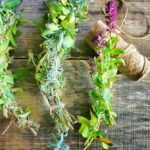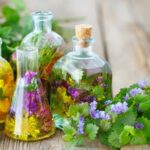How to Use Allspice
Pimenta dioica of Myrtaceae
This post might contain affiliate links.
The shiny leaved herb tree of allspice is pleasantly aromatic and known for its notable benefits both as a spice and in nutrition. This vigorous spice originated from the dried fruit of the pimento tree, thus it is commonly called Jamaica pepper, pimenta, or pimento. As a result of its healthful qualities, it gently spread geographically throughout the world through trade and use. It was named allspice due to the dried brown berries which is similar to a peppercorns, and the aroma and taste like the blend of nutmeg, cinnamon and cloves. What makes this spice even more appealing is the high absorption of beneficial nutrients and organic compounds that result in the remarkable health perks of allspice.
History
Allspice or Jamaica Pepper was discovered by Christopher Columbus in the Caribbean Islands of Jamaica in 1494. He was 45 years old when he visited the island of Jamaica and found the herb they used through interacting with native cultures. On his second jaunt to Jamaica, he proved to his supporters that he had found a real black pepper at its source. He called the spice “pimienta” a Spanish term for pepper. Dried Jamaican pepper is similar to a large-brown peppercorn. In 1509 Spanish explorers and frontier settlers of Jamaica initiated the use of the leaves and berries of the trees. On 1601 allspice reached London, and England started propagating elsewhere in its territories through 1732. There was a high demand for allspice during World War II due to its nutritional content, and manufacturing of allspice inevitably dwindled as a result of large scale destruction of allspice trees to meet such a high supply rate. Subsequently the production of allspice increased afterward, but has never fully recovered since then. The herb is thus rather costly and not as common as standard black pepper. Even in the present day, allspice is considered an upscale spice in international markets for its exceptional flavor. It is grown commercially in Mexico, Trinidad, Jamaica, Cuba, Honduras and Guatemala as one of the only spices that is primarily grown exclusively in the new world. The United States, United Kingdom, Finland, Germany, Canada and Sweden are leading importers of this spice and herb as well.
Allspice is also known as myrtle pepper as it grows on a kind of myrtle ground similar to California and Turkey’s bay leaves. It was then again renamed when it reached England and finally settled on the name “Allspice” because the English thought it tasted like a mix of nutmeg, cinnamon, pepper and cloves.
Taxonomy
Kingdom: Plantae
Clade: Angiosperms
Clade: Eudicots
Order: Myrtales
Family: Myrtaceae
Genus: Pimenta
Species: P. dioica
Binomial Name: Pimenta dioica
Lore
In ancient times, allspice was used by the Mayans as an embalming agent. Native South Americans also use it to flavor chocolates. While the Arawaks (a group of indigenous people of South America and the Caribbean) used it to preserve meat.
This fragrant herb is also linked with the element of fire and the planet Mars. It is masculine in nature, very manly and used to honor very vibrant and compelling male archetypes. This spicy herb is very invigorating and can boost energy and tenacity making it favorable in many different types of spells, including energizing and healing spells. The dried berries, oil and allspice incense can be burned to benefit spells to bring in money or luck. The new world herb was used traditionally in healing mixtures and tinctures, too.
Uses
Medicinal
You may think that allspice is just a pepper or a seasoning but this herb is replete with healthy benefits that aids in an array of medical conditions. One of the most significant benefits is to diminish inflammation that causes arthritis and other body aches. It also gives relief in your digestion. Feel bloated and gassy? Allspice perfectly aids in flatulence. It will ease your tummy rapidly. The reason for this being the herb consists of more than a dozen antioxidants including eugenol, quercetin, and ellagic. Ellagic acid contains anti-cancer effects and reduces proliferation of pancreatic cancer cells while boosting free radical absorbing antioxidants in our body. These antioxidant properties also help in benefiting the immune system by enhancing antimicrobial and anti-bacterial effects within the body.
In addition to all of this, this aromatic spice has a very low Glycemic index making it a good spice for diabetics to consume. Nutritionally, the herb contains numerous vitamins and minerals like iron and copper (which promotes red blood cell growth) hence it improves blood circulation as well. As mentioned above, allspice contains antimicrobial agents that can be helpful to even our teeth from bacterial pathogens when drunk as a tea. Allspice oil can be applied to a painful tooth or gum abscess as a first aid treatment until dental work can be done.
These same elusive oils contain eugenol (a weak antimicrobial agent) that actually lends the herb to being a good one for deodorant development.
Culinary
Allspice is considered as one of the most essential ingredients of Caribbean cuisine. It is one of the primary seasonings of Caribbean jerky. It is also one of the main ingredients in commercial sausage preparations and curry powders. Allspice is also a vital additive in Middle Eastern cuisine where it is used to flavor assorted meat dishes and stews. They often use allspice in America and Great Britain for savory desserts such as cakes.
Aside from making it a seasoning to a variety of meats and dishes, allspice can also be brewed as an herbal tea. It has numerous health benefits in tea form that include digestive stimulation and is filled with vitamins and minerals.
Spiritual
To add energy to other spells burn a charcoal tablet or grind into incense this herb for money and good luck. They say that you should carry allspice berries in a little pouch to increase the fortune of business ventures and not to be susceptible to deplorable business decisions. It is also magically thought to attract money and help relieve mental tension. Magical links include healing, compassion, energy and fertility renewal.
Growing Tips
Allspice can be grown in temperate climates. It can be grown in tropical and subtropical countries, too, as a houseplant as it adapts well in container gardening. It can grow in full sun, although for the first few months it is recommended to have some partial shade for initial rooting. It is best grown in well drained sandy loam soil. Sow the seeds after harvesting, and the seeds germinate after ten (10) days. The plant is dioecious meaning it requires both male and female plants to fertilize each other to fruit. It only produces berries on the females though. The ripe berries are known to be a great additive in baking. It begins to fruit after three (3) years and is in full bearing in four (4) years of growth. Flowers normally appear from June to August.
Word of Caution:
Allspice may cause allergies in some individuals. Women should avoid consuming it during pregnancy and breastfeeding due to its affect on circulation and digestion. It is also not the best with gastrointestinal conditions such as duodenal ulcers and reflux esophagitis. Consult your physician for further information.
Conclusion
Allspice is a delectable source of vitamin and mineral packed goodness. It not only gives us health benefits but can also be essential in culinary uses. It may be pricey on the market, but comes with many benefits to those who use or take the time to grow it. After learning more about this new world herb, I hope it brings a lot of nutritional fun to your household.
Check out Eupterra’s main page for more informative reading and subscribe to our newsletter to get more herblore 🙂
Citations:
“Witchipedia.” Allspice – Witchipedia, www.witchipedia.com/herb:allspice.
Herbalriot. “Magickal Uses of Allspice.” Herbal Riot, 21 Aug. 2013, herbalriot.tumblr.com/post/58910687073/magickal-uses-of-allspice.
www.gardeningknowhow.com/edible/herbs/allspice-pimenta/allspice-for-cooking.htm.
“Allspice.” Wikipedia, Wikimedia Foundation, 25 Feb. 2018, en.wikipedia.org/wiki/Allspice.









Leave A Reply!